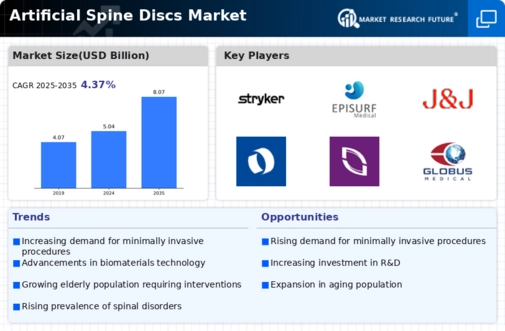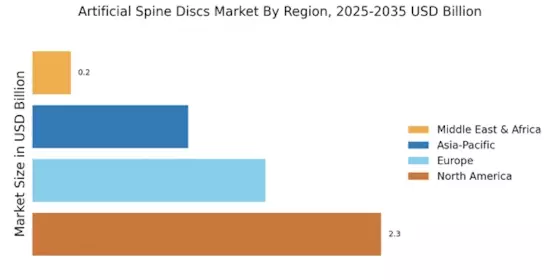Growing Awareness of Spine Health
The growing awareness of spine health among the general population is driving the Artificial Spine Discs Market. Educational campaigns and increased access to information have led individuals to prioritize their spinal health, recognizing the importance of early intervention for spine-related issues. This heightened awareness is likely to result in more patients seeking medical advice and treatment options, including artificial spine discs. Furthermore, as people become more proactive about their health, the demand for minimally invasive surgical options is expected to rise. This trend may lead to an increase in the number of procedures performed, thereby benefiting the Artificial Spine Discs Market. The focus on preventive care and education is anticipated to play a pivotal role in shaping market dynamics.
Increasing Healthcare Expenditure
Rising healthcare expenditure across various regions is a crucial factor propelling the Artificial Spine Discs Market. As governments and private sectors invest more in healthcare infrastructure, the availability of advanced medical technologies, including artificial spine discs, is improving. Data indicates that healthcare spending is projected to grow at a compound annual growth rate of 5.4% over the next several years. This increase in funding allows for better access to surgical procedures and innovative treatments, thereby expanding the market. Additionally, as patients become more aware of their treatment options, the demand for artificial spine discs is likely to rise, further stimulating market growth. The Artificial Spine Discs Market stands to gain from this upward trend in healthcare investment.
Expansion of Distribution Channels
The expansion of distribution channels for artificial spine discs is a notable driver of the Artificial Spine Discs Market. As manufacturers seek to reach a broader audience, they are increasingly partnering with hospitals, clinics, and online platforms to enhance product availability. This diversification of distribution methods allows for greater accessibility to advanced spinal solutions, particularly in underserved regions. Additionally, the rise of e-commerce in the medical field is facilitating direct-to-consumer sales, which may further boost market penetration. As distribution networks continue to evolve, the Artificial Spine Discs Market is likely to experience increased growth opportunities, enabling more patients to benefit from innovative spinal treatments.
Rising Prevalence of Spine Disorders
The increasing incidence of spine disorders, such as herniated discs and degenerative disc disease, is a primary driver for the Artificial Spine Discs Market. As populations age, the prevalence of these conditions tends to rise, leading to a greater demand for effective treatment options. According to recent data, approximately 80% of individuals experience back pain at some point in their lives, which underscores the necessity for innovative solutions. This growing patient population is likely to propel the market forward, as healthcare providers seek advanced technologies to address these challenges. The Artificial Spine Discs Market is thus positioned to benefit from this trend, as more patients seek surgical interventions to alleviate pain and restore mobility.
Technological Innovations in Spine Surgery
Technological advancements in spine surgery are significantly influencing the Artificial Spine Discs Market. Innovations such as 3D printing, robotic-assisted surgery, and improved imaging techniques are enhancing surgical outcomes and patient safety. These technologies not only facilitate more precise procedures but also reduce recovery times, making them appealing to both surgeons and patients. The market is witnessing a surge in the adoption of these advanced techniques, which are expected to drive growth. Furthermore, the introduction of smart implants that can monitor patient progress may revolutionize the industry, providing real-time data to healthcare providers. As these technologies continue to evolve, they are likely to create new opportunities within the Artificial Spine Discs Market.


















Leave a Comment